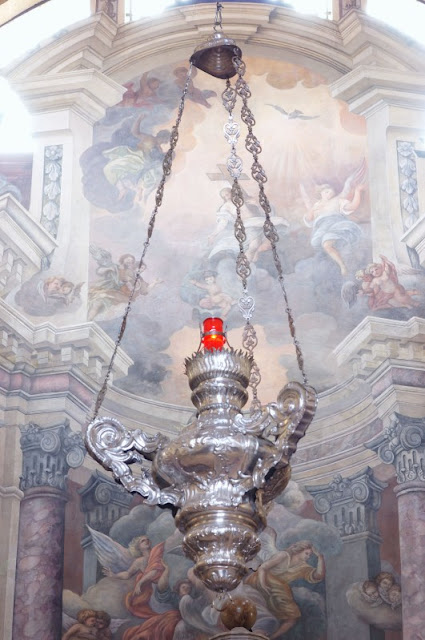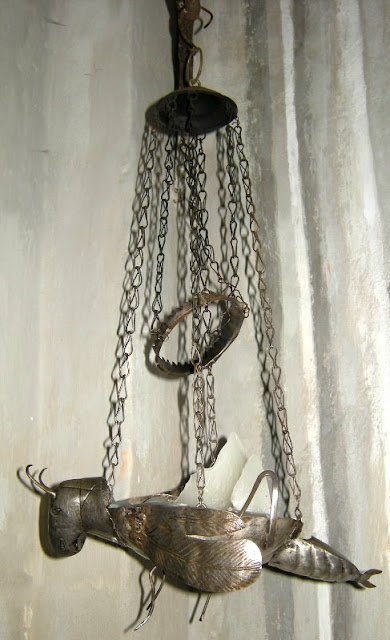One of the elements found within churches that are at one at the same time both readily noticed and at the same time readily ignored are "lampada" -- or, to sound slightly less exotic, lamps. That might sound like a contradiction of course; how can something be both readily noticed and also readily ignored? Well the answer is simple. In many churches the only lamp -- often referred to as the vigil lamp -- is that which is located by the tabernacle in the church and, as such, generally the way this goes is the person sees the lamp and immediately shifts their focus toward the tabernacle and what is contained within. In other words, our attention very quickly shifts away -- and understandably so.
Of course if you go into many older churches, there is generally more than one lampada to be found. In various of the churches of continental Europe, for instance, one will still sometimes see them hanging between columns like the basilica lighting of old; one will also see clusters of lamps and so on.
 |
| Ss. Trinita dei Pellegrini, Rome |
The main point here is whether we are dealing with the one or the other scenario, lampada are an easily missed object of liturgical art and yet they really are worth stopping to look at. They are not only frequently beautiful in their form, they also can be a reminder of the antiquity of the faith; a faith which ties the ancient world to the modern one.
 |
| Lamps shown hanging from the ciborium over the altar. Lower basilica, San Clemente, Rome. |
In view of that, today I am simply presenting a brief survey over some lampada, mostly coming from the 1600's onward. Lamps from this period all generally take on a relatively similar basic shape and form and in that regard, it can be difficult to date any given lamp based purely on the basic form alone. To get to that level of detail one might have to look for clues in the design, such as for example the use of neo-classical design elements, which would at least point to a lamp having come from the neo-classical period or later. Of course, the gothic revival saw many lamps taking on more gothic forms and as such these are the easiest to identify in terms of them coming from the nineteenth or twentieth century.
There are exceptions however -- there always are -- and at the end of this article we will show some lamps from both the early modern and antique periods whose forms are rather different.
Little commentary is needed for these examples. I would simply invite you to take a moment to a look at each of these, observing the beauty of their designs and imagine them being put to their liturgical-ecclesaiastical purpose.
The next time you're in a church, stop and take a look at the beauty of the lamps you might find there.
 |
| Venice, 1756 |
 |
| 19th century, Lazio |
 |
| 18th century |
 |
| 1869 |
 |
| 1761 |
 |
| Venice, 1682 |
 |
| Italy, 1854 |
 |
| Catania, 1786 |
 |
| Naples, 1650 |
 |
| Venice, 1851 |
 |
| Italy, 1865 |
 |
| 1696 |
 |
| First half of the 18th century |
As will have noticed by now, many of these lampada have very similar characteristics in terms of their shape, but it is not always so. When we hear of lampada from the paleochristian period for instance, they frequently take on a zoomorphic form -- which is to say, shaped like animals. One of those famous mentions comes from the Liber Pontificalis which talks about the Constantinian donation of silver lamps in the form of dolphins. This can be difficult for us, as moderns, to imagine precisely because we are so accustomed to the shapes we have just been showing. To help with that, here are a few examples of lampada that take on some of these other forms.
Here is a very curious and unique one from Cagliari, Sardegna, for instance, dated to the 15th-16th century and comes in the form of a bee.
 |
| Sardegna, 16th-17th century |
Here too is another coming in the form of a peacock from Byzantium, dated to the sixth to seventh century.
 |
| Byzantium, 6th-7th century |
Finally, there is this one, in the form of a dove / Holy Spirit which comes from eighteenth or nineteenth century Naples:














